If a Thermostat in a 2017 Ford Focus Sticks Open Is It Possible for It to Start Working Again
Thermostat: how it works, symptoms, issues, testing
Updated: May 08, 2022
The thermostat is a key component of the engine cooling system. The cooling system keeps the engine from overheating. The system is filled with liquid coolant (antifreeze) and is continued into a loop with a radiator, see the diagram.
The coolant flows through the engine where it absorbs the rut and into the top of the radiator. The radiator is built of many flat aluminum tubes surrounded by fins. The air passing through the radiator cools down the coolant as it flows down the radiator.
I or ii electrical fans fastened to the back of the radiator turn on when needed to strength more air through the radiator. A water pump pulls the coolant out of the radiator and pushes it back into the engine.
The normal operating temperature of a modern engine is between 194°F (90°C) and 221°F (105°C).
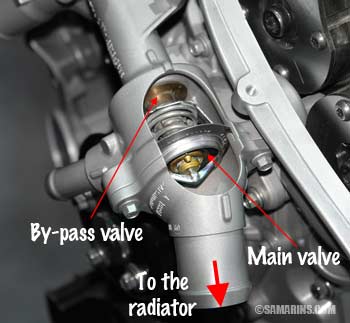 Thermostat inside the housing. Ford engine cutaway. Click for a larger photo
Thermostat inside the housing. Ford engine cutaway. Click for a larger photo
The job of a thermostat is to help the engine warm upward faster and maintain the engine temperature above the minimum operating temperature (194°F or 90°C). A conventional thermostat is a uncomplicated temperature-controlled two-way valve that opens at a specified temperature. In almost cars, a thermostat is installed on the engine and is continued to the upper or lower radiator hose. Read how the thermostat works and see the diagrams below.
See a few examples: thermostat in a Ford 2.3L EcoBoost engine. This photo shows the thermostat housing in the Mazda ii.3L turbo DISI engine. This is the photo of a thermostat housing in the Dodge Charger SRT Hemi engine.
Symptoms of a bad thermostat
Symptoms of a bad thermostat tin can exist divided in two types:
Thermostat stuck open: When the thermostat is stuck open up, the engine temperature drops below normal when driving, particularly on the highway in cold weather. A stuck-open up thermostat can besides cause lack of estrus from the heating system. The Check Engine light may come on too.
Thermostat stuck closed: When the thermostat is stuck closed, the engine might overheat. Likewise these ii cases, the thermostat may likewise demand to be replaced if the thermostat housing is leaking coolant.
The engine takes very long to warm upwards, can information technology be caused by a thermostat?
Yes, a thermostat that is stuck open is i of possible reasons why it may accept too long for the engine to warm up. A low coolant level can also cause the aforementioned problem. In many modern cars, however, it's actually normal.
Many late-model cars have smaller fuel-efficient engines. This ways they burn less fuel and as a consequence, produce less oestrus. In addition, newer technologies that reduce friction inside the engine also reduce the corporeality of heat generated past friction.
In many newer cars it takes up to 20-25 minutes of driving before you tin can go decent oestrus going in wintertime. A heater may also be not as strong as in older cars with a larger engine. It's a merchandise-off for amend gas mileage. As we mentioned, ane sign that the thermostat is stuck open (or missing) is when the engine temperature drops below normal when driving on the highway in common cold weather.
How the thermostat is tested
When dealing with any cooling organisation problem, the coolant level is checked starting time. Read more: how to check the coolant level.
In old days, testing of the thermostat involved removing and heating information technology while submerged in water. At the temperature marked on the thermostat, it would outset opening. In modernistic cars, the operation of the thermostat is monitored by the engine calculator (PCM). In almost cases, if a thermostat is stuck closed or open up, the Bank check Engine lite would come on. Most common Bank check Engine calorie-free codes related to a thermostat are P0128 and P0126.
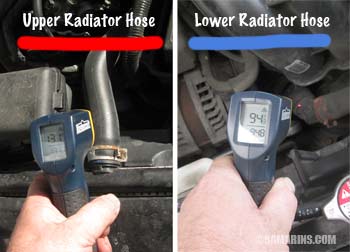 Mechanic measures radiator hose temperature with an infrared thermometer
Mechanic measures radiator hose temperature with an infrared thermometer
Can y'all test a thermostat without removing it? Mechanics test the thermostat by measuring the temperature of the upper and lower radiator hoses with an infrared thermometer, while monitoring the engine temperature with a scan tool. See the nautical chart below. In this chart, the yellow line is the temperature of the engine, the red line is the temperature of the upper radiator hose and the blue line is the temperature of the lower radiator hose.
When the engine is started common cold, the upper hose warms up with the engine, simply since there is no flow through the radiator, the lower radiator hose remains common cold.
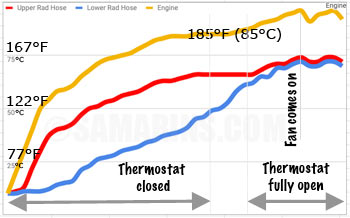 The engine warms up at idle. The yellow line is the engine temperature. The thermostat opens at 185°F (85°C) and the temperature of the lower radiator hose (blue line) becomes virtually the aforementioned as the temperature of the upper radiator hose (red line).
The engine warms up at idle. The yellow line is the engine temperature. The thermostat opens at 185°F (85°C) and the temperature of the lower radiator hose (blue line) becomes virtually the aforementioned as the temperature of the upper radiator hose (red line).
In this Honda in the nautical chart, the thermostat starts opening at about 185°F (85°C). As the thermostat opens and coolant starts flowing through the radiator, the temperature of the lower radiator rises quickly close to the temperature of the upper hose. At almost 204°F (96°C), the radiator fan comes on and the temperature drops a few degrees. The thermostat in this car works properly.
If a thermostat was stuck open, the lower radiator hose would start warming upward every bit shortly as the engine is started.
If a thermostat was stuck closed, there would be no period even after the engine reached the operating temperature, and the lower radiator hose would remain absurd.
Of course, lack of flow through the radiator tin be caused by many other reasons besides a stuck-closed thermostat. If a thermostat is stuck airtight, the engine might overheat, which can result in expensive repairs. If there is a suspicion that the thermostat is stuck closed, information technology's normally replaced.
Thermostat replacement
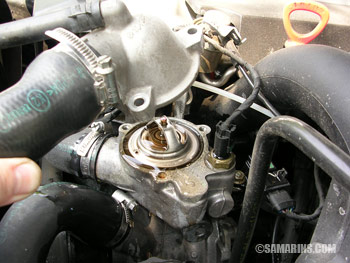 Replacing a thermostat
Replacing a thermostat
In an average vehicle replacing a thermostat may toll $150-370 parts and labor. In some cars the access to the thermostat is difficult, requiring more labor. A new thermostat normally comes with a new gasket. When the thermostat is replaced, the engine will need to be refilled with fresh coolant (antifreeze). The cooling system volition need to be properly bled, to remove all air pockets.
Afterwards servicing the cooling organisation, information technology'southward always important to verify that the fans come up on when the engine is fully warmed up and the heating arrangement inside the automobile tin provide a good heat at idle. Lack of heat at idle can be caused by air pockets inside the cooling arrangement.
Should the thermostat be replaced equally a part of regular maintenance? It's not necessary, however, information technology might be a good idea to replace a thermostat when the engine is rebuilt or replaced.
A thermostat is also frequently replaced together with a water pump, especially if they are located in the same area.
Some manufacturers recommend updating the engine computer software when at that place is a Check Engine code related to the thermostat, after it has been replaced. We posted several links where you tin can go a subscription fee based admission to a factory repair manual in this article.
How the thermostat works in a car
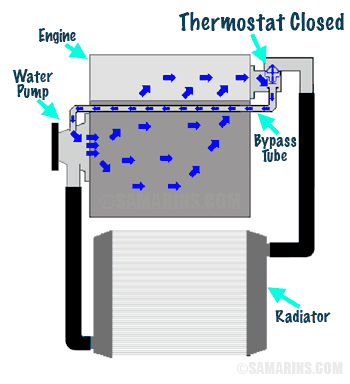 Thermostat is closed
Thermostat is closed
Thermostat is airtight:
When the engine is started common cold, the thermostat (the main valve) is airtight; in that location is no flow through the radiator. The smaller thermostat featherbed valve is open and the coolant circulates through the bypass tube within the engine and through the vehicle heating system. This allows the engine warm upward faster.
Thermostat is open:
As the engine warms upwards closer to the operating temperature, the thermostat valve gradually opens upward, allowing coolant flow through the radiator.
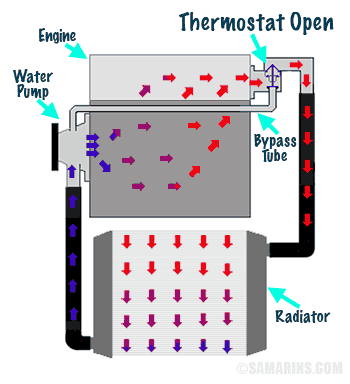 Thermostat is open
Thermostat is open
The coolant enters the top portion of the radiator and cools down as information technology flows through the radiator. The water pump pulls the cooled coolant dorsum into the engine.
In common cold weather, if the engine temperature drops close to the lower limit of the operating range (194°F or 90°C), the thermostat closes again.
Many modern cars use an electronically controlled valve called "coolant control valve" instead of a conventional thermostat. The coolant control valve works the same manner simply it'due south operated by the engine computer and is more precise.
Source: https://www.samarins.com/glossary/thermostat.html